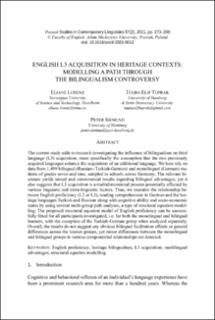English L3 acquisition in heritage contexts: Modelling a path through the bilingualism controversy
Peer reviewed, Journal article
Published version

Åpne
Permanent lenke
https://hdl.handle.net/11250/3003481Utgivelsesdato
2021Metadata
Vis full innførselSamlinger
- Institutt for lærerutdanning [3692]
- Publikasjoner fra CRIStin - NTNU [38127]
Originalversjon
Poznan Studies in Contemporary Linguistics. 2021, 57 (2), 273-298. 10.1515/psicl-2021-0012Sammendrag
The current study adds to research investigating the influence of bilingualism on third language (L3) acquisition, more specifically the assumption that the two previously acquired languages enhance the acquisition of an additional language. We here rely on data from 1,409 bilingual (Russian-/Turkish-German) and monolingual (German) students of grades seven and nine, sampled in schools across Germany. The relevant literature yields mixed and controversial results regarding bilingual advantages, yet it also suggests that L3 acquisition is a multidimensional process potentially affected by various linguistic and extra-linguistic factors. Thus, we examine the relationship between English proficiency (L2 or L3), reading comprehension in German and the heritage languages Turkish and Russian along with cognitive ability and socio-economic status by using several multi-group path analyses, a type of structural equation modelling. The proposed structural equation model of English proficiency can be successfully fitted for all participants investigated, i.e. for both the monolingual and bilingual learners, with the exception of the Turkish-German group when analyzed separately. Overall, the results do not suggest any obvious bilingual facilitation effects or general differences across the learner groups, yet minor differences between the monolingual and bilingual groups in various componential relationships are detected.